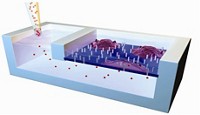Advertisement
Grab your lab coat. Let's get started
Welcome!
Welcome!
Create an account below to get 6 C&EN articles per month, receive newsletters and more - all free.
It seems this is your first time logging in online. Please enter the following information to continue.
As an ACS member you automatically get access to this site. All we need is few more details to create your reading experience.
Not you? Sign in with a different account.
Not you? Sign in with a different account.
ERROR 1
ERROR 1
ERROR 2
ERROR 2
ERROR 2
ERROR 2
ERROR 2
Password and Confirm password must match.
If you have an ACS member number, please enter it here so we can link this account to your membership. (optional)
ERROR 2
ACS values your privacy. By submitting your information, you are gaining access to C&EN and subscribing to our weekly newsletter. We use the information you provide to make your reading experience better, and we will never sell your data to third party members.
Analytical Chemistry
Nanotube needles deliver quantum dots
May 14, 2007
| A version of this story appeared in
Volume 85, Issue 20
Multiwalled carbon nanotubes can be used as nanoinjectors to deliver quantum dots inside cells, a technique that could enhance studies of cellular processes (Proc. Natl. Acad. Sci. USA, DOI: 10.1073/pnas.0700567104). A team led by Carolyn R. Bertozzi and Alex Zettl at the University of California, Berkeley, and Lawrence Berkeley National Laboratory created the devices by first connecting a single nanotube to an atomic force microscope tip. Then the researchers attach a quantum dot to the nanotube via a linker that has a pyrene moiety at one end, a biotin moiety at the other end, and a disulfide bond in the middle. The pyrene adsorbs to the nanotube while the biotin binds to streptavidin on the surface of the quantum dot. As the nanotube needle pokes through a cell membrane, the reducing environment of the cytosol cleaves the disulfide bond, which releases the quantum dot inside the cell. The researchers tracked quantum dots injected into human cells, noting that the delivery method appears to leave the cells unharmed.




Join the conversation
Contact the reporter
Submit a Letter to the Editor for publication
Engage with us on Twitter